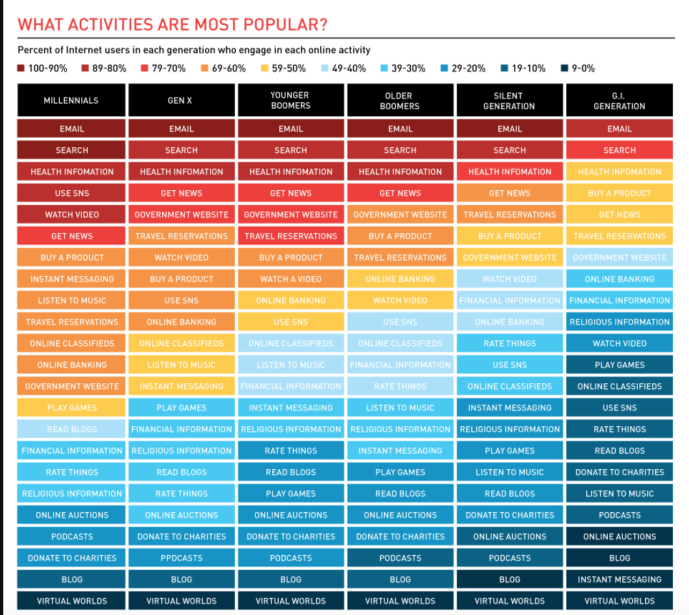In this digital age, it is more shocking to know if one does not have access to web in a well-developed country. Every user access the web for various reasons and your personal values create the “digital differences” of your online behaviour.
This infographic illustrated how people from the different generations on how they use the web (Sitejabber, 2011).

According to this infographic, the first three online activities are the same across all generations but using social media is the fourth popular activity for millennials compared to the majority getting news.
I would rank my first 8 activities in this order:
- Search
- Use SNS
- Get news
- Instant messaging
- Watch videos
- Listen to music
- Buy a product
One’s digital behaviour is unique as it could be because it is based on his personal values and beliefs (Halford et. al., 2017). I used the web for mainly knowledge-based purposes such as for academic or getting news. Even while surfing through social media, I would keep an extra lookout for current news updates. Compared to someone who is constantly creating and posting original content on the web, I make lesser impact as a visitor than a resident.
Blessed with latest fibre broadband connection and devices, I have a stronger advantage over people who do not have access to these privileges. Massive Open Online Courses (MOOC) like Futurelearn and edX can provide professional help in my academic areas (Mooc-List.com, 2017). People who do not have access would not be able to know what is happening out of their area such as villages in India.
Tapping on my endless curiosity to know about the world’s latest happenings, my digital difference clearly makes a significant difference in my life; the way I look, experience and feel all aspects of life.
Please feel free to enlighten me with your wisdom on your digital difference compared to mine.
(307 words)
Cheers,
Jocelyn Goh
Sources:
Halford, S., Davies, H., & Dixon, J. (2017). Page from Learning in the Network Age – University of Southampton. FutureLearn. Retrieved from https://www.futurelearn.com/courses/learning-network-age/3/steps/263012
MOOC List. (2017). MOOC List. Retrieved from https://www.mooc-list.com/
SiteJabber. (2011). Retrieved from https://www.sitejabber.com/resources/wp-content/uploads/2011/01/sjgen.png
Zickuhr, K., & Smith, A. (2012). Cite a Website – Cite This For Me. Pewinternet.org. Retrieved 10 November 2017, from http://www.pewinternet.org/files/old-media/Files/Reports/2012/PIP_Digital_differences_041312.pdf

Hi Jocelyn, the table of information showing the activities that one uses is interesting, I did not expect “emails” to be ranked first for the gen-x and the millennials. Do you think that this study also included work related activities instead of solely individual personal usage?
I agree that we are fortunate to be able to access the internet and the wide source of information that is available online (note your example on a less developed village in India). Do you think that development of the country/area is the greatest factor for the digital differences in the world?
(Word count: 100)
LikeLike
Hi Xinyi, thanks for the comment! This study includes both work related activities and personal usage (concluded as “Internet Activity”. According to Radicati Group research on email users, there are currently 3.7 billion, about 54% of the world’s population are using email! It is still possible for millennials and gen-x to check email daily for online shopping promotional newsletters or simply for formal communication purposes.
I do agree that development of the country/area is the greatest factor for the digital differences in the world. For example, based on Internet Live Stats (2016), a smaller country like Japan, has 91.1% Internet penetration rate as compared to a bigger developed country like America (88.5%). China is at 52.2% and Singapore is at 82.5%, significantly higher than China. As much as 50 percent of offline individuals have an income below the average of their respective country’s poverty line and median income (Mckinsey, 2014). Hence, we can see that the development of the country is one the greatest factor for the digital differences.
Do let me know your thoughts!
(Word count: 169)
Sources:
Internet Users by Country (2016) – Internet Live Stats. (2017). Internetlivestats.com. Retrieved 13 November 2017, from http://www.internetlivestats.com/internet-users-by-country/
Offline and falling behind: Barriers to Internet adoption. (2017). McKinsey & Company. Retrieved 13 November 2017, from https://www.mckinsey.com/industries/high-tech/our-insights/offline-and-falling-behind-barriers-to-internet-adoption
Radicati.com (2017). Email Statistics Report, 2017-2021. Retrieved 13 November 2017, from http://www.radicati.com/wp/wp-content/uploads/2017/01/Email-Statistics-Report-2017-2021-Executive-Summary.pdf
LikeLike
Hi Jocelyn, thank you for your insights. As someone who does not do much online shopping, I omited such activities when considering the use of email even though i read a lot of newletters and promotional emails! Thank you for your sharing 😊 I’ll look forward to your future posts!
LikeLike